
Bible, History, Archaeology
Bible,
History,
Archaeology
Nebuchadnezzar II,
its policy in the Levant, its construction
Contents:
introduction with the cylinder image – Nebuchadnezzar II – A fresco depicting a lion hunt – Cylinders and their functions – The destruction of the first Temple – Chief eunuch of the Neobabylonian army – The biblical Nebuchadnezzar – The two dreams of Nebuchadnezzar II – Image of the statue – Ishtar's gate – Image of the lions at Ishtar's gate – Mushkushu – The Processional Way – The Ishtar Gate and the Processional Way – History of archaeological excavations
Introduction
On April 9, 2014, New York's Doyle, considered one of the world's leading art and artifact auctioneers and appraisers, auctioned a Babylonian cuneiform cylinder of Nebuchadnezzar II (the Nebuchadnezzar of the Bible). The sale of this rare and important cylinder set a new world auction record for a Babylonian cylinder.
The price originally set for this artifact was 500,000 $, but it was eventually awarded to an anonymous bidder for 605,000 $.
This cylinder was unearthed in 1879 on the site of ancient Babylon by a team of archaeologists from the British Museum in London.
Image opposite: the 20.8 cm clay cylinder with text detail describes Nebuchadnezzar II's reconstruction of the Temple of Shamash at Sippar (now Tell Abu Habbah, Iraq), dating back to the Neo-Babylonian period, circa 604-562 BC.
To view Nebuchadnezzar II's cylinder, click on the image.
Nebuchadnezzar II
Nebuchadnezzar II (Nabu-kudurri-usur) appears in history as the most important of the last kings of Babylonia, who reigned from 604 to 562 B.C. He was the second of the eleventh dynasty of Babylonian rulers (the so-called Neo-Babylonian or Chaldean dynasty), which lasted until the capture of Babylon by the Persian king. Cyrus II the Great. Nebuchadnezzar II was the eldest son and successor of the Chaldean king Nabopolassar (Nabu-apla-usur), founder of the dynasty. Nabopolassar had taken control of Babylonia from King Sinsharishkun of Assyria, in the process of expelling the Assyrian armies from Babylonia, in 616 B.C. Joining forces with Cyaxare, king of the Medes, he ravaged Nineveh from top to bottom in 612 B.C., which would disappear from the memory of mankind, according to the prophecies of the books of Nahum and Zephaniah, which describe its destruction (Nahum 3,1-19; Sophonie 2 and 3, 1-7).
 Image opposite: a cartouche on a jar bearing the name of Neco (or Nekao II). He successfully waged war against Josiah, king of Judah, who was killed at the battle of Megiddo in 609 BC. Three months later, he captured Jehoahaz, Josiah's son and his successor as head of Judah, who died in Egypt, and imposed a tribute on the kingdom of Judah. Finally, he established Joiakim, Josiah's eldest son, as the new king of Judah. This episode is recalled in the Bible, more precisely in the Second Book of Kings, chapter 23, verses 30 to 35 © Gift of Jerome F. Snyder.
Image opposite: a cartouche on a jar bearing the name of Neco (or Nekao II). He successfully waged war against Josiah, king of Judah, who was killed at the battle of Megiddo in 609 BC. Three months later, he captured Jehoahaz, Josiah's son and his successor as head of Judah, who died in Egypt, and imposed a tribute on the kingdom of Judah. Finally, he established Joiakim, Josiah's eldest son, as the new king of Judah. This episode is recalled in the Bible, more precisely in the Second Book of Kings, chapter 23, verses 30 to 35 © Gift of Jerome F. Snyder.
Nebuchadnezzar himself defeated an Egyptian army (under Pharaoh Neco II) at Karkemish in a battle that consolidated his control over the region and severely reduced the power of Egypt, which fell under the sway of the neo-Babylonian ruler. He was an empire builder who led successful campaigns against most neighboring states, including Phoenicia, Philistia, Judah, Ammon, Moab and others, and in the process acquired considerable wealth and power.
A fresco depicting a lion hunt in Nineveh, in the palace of the Assyrian king Assurbanipal. © Théo Truschel.
Cylinders and their functions
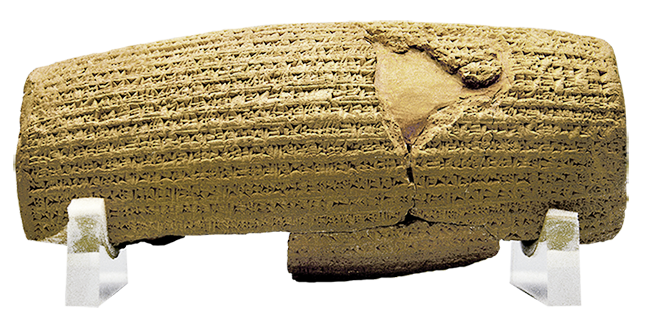
Image opposite: Cyrus II's cylinder in which the sovereign declares authorization for the return of all Babylonian exiles © Théo Truschel.
This very public act also helped create an appearance of legitimacy for the ruler with his subjects and vassals. For example, the Cyrus Cylinder (539 BC, an edict for the return of all Babylonian exiles), one of the greatest examples in existence, praises Cyrus as a benefactor. It's worth noting that the latter had acceded to the throne by deposing the Babylonian king Nabonidus, and he apparently believed that this and similar rituals would legitimize his position with the gods and his subjects.
The destruction of the First Temple
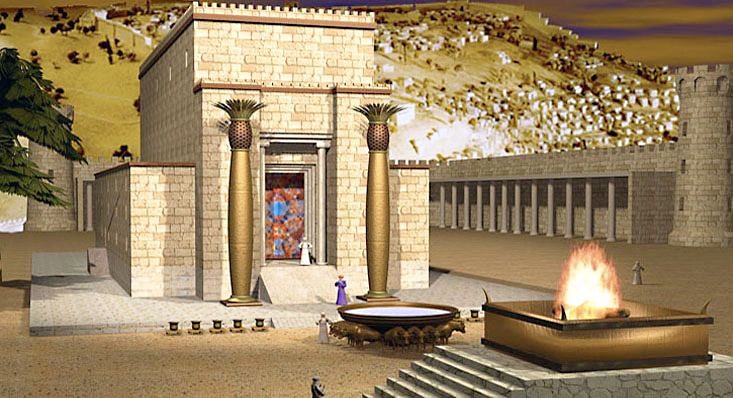
Image opposite: a 3d proposal of Solomon's Temple in its version with the covered vestibule. © Théo Truschel.
Image opposite: Pharaoh Hophra (or Apries). In 588 BC, Hophra took up the fight against Nebuchadnezzar II, who had seized Jerusalem (third deportation of the Jews to Babylon). He seized Gaza and supported Tyre and Sidon in their resistance to the Babylonians. Public domain.
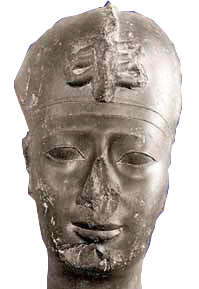
«...He burned the house of the Lord, the king's house, and all the houses of Jerusalem; he delivered all the houses of any importance to the fire. All the army of the Chaldeans, which was with the chief of the guards, demolished all the walls forming the enclosure of Jerusalem. Nebu-zar-adan, chief of the guards, took captive some of the poorest of the people, those who had remained in the city, those who had surrendered to the king of Babylon, and the rest of the multitude...».
It was at this point in the Scriptures that the Ark of the Covenant of the Temple of Jerusalem disappears from history.
«Chief eunuch» of the Neo-Babylonian army
A recent translation of a cuneiform tablet unearthed in the 1870s in the ancient city of Sippar reveals the name of Nebo Sarsekim (biblical name). He would have been present at the siege of Jerusalem in 586/587 BC with Nebuchadnezzar II. Nebo Sarsekim is mentioned in Jérémie 39.3 as «chief eunuch» (rab ša-rēši). The translation of the cuneiform text confirms its exact function and gives us Nabu-Sharrussu-Ukin's full name and title. A rare feature of this type of document is the precise date, the tenth year of the reign of Nebuchadnezzar II, some 8 years before the events reported in the book of Jérémie, is mentioned on the tablet. © D.R.
To view the tablet discovered at Sippar, click on the image.
The biblical Nebuchadnezzar
The dream of Nebuchadnezzar and Daniel
A large part of Daniel describes this prophet's experiences at the court of Nebuchadnezzar. The king was troubled by dreams or visions, and demanded that the wise men of his court tell him both what he had dreamed and its interpretation. Daniel, then in exile at the king's court, was the only man who (by divine intervention) could tell Nebuchadnezzar what his dream was and explain its meaning.
Consequently, Nebuchadnezzar lavished him with gifts, placed him above all other wise men, and appointed him ruler of the province of Babylon.
The two detailed dreams of Nebuchadnezzar II
In Daniel chapter 2, Nebuchadnezzar II sees in a dream a huge statue made of various metals and clay. These materials have a decreasing value from the head to the feet. It is Daniel who will reveal to the king the course of history over a period of 25 centuries:
– Babylon is the head of gold absolute authority characterizes this regime, where the king is a sacred person; Scripture likens it to tyranny (Isaiah 14:4).
- The authority of the Medes and Persians will be less, moving from the dictatorship of a single man to an oligarchic system, a government of families. Written law will even prevail over the will of a king (Daniel 6,8-9).
- The Greco-Macedonian empire, the third political power, corresponds to the bronze thighs of the statue; it is a military regime.
- Then the Roman Empire, The fourth is imperial and dictatorial. This stage of the story corresponds to the statue's iron legs, followed by the feet, which are partly iron and partly clay. It's a curious alloy, the end result of which will be the crumbling and shattering by a stone (verse 34). We'll need chapter 7 to grasp the significance of these ten toes, which correspond to ten nations.
In chapter 7, the four large animals represent four kings, or the four kingdoms or empires of antiquity:
- The eagle-winged lion symbolizes Babylon: archaeologists have found this emblem on the city's gates.
- The bear swallowing three ribs refers to the empire of the Medes and Persians, whose military conquests were directed towards the South, the West and the North (Babylon, Egypt and Asia Minor).
- The leopard with four wings and four heads prefigures the lightning conquests of Alexander the Great, and the role of his four generals who shared his Empire after Alexander's sudden death in 323 BC.
- As for the fourth animal, The rigors of Rome's yoke are evoked by its iron teeth, in parallel with the statue's iron legs. The ten toes of the statue and the ten horns of the monster (Daniel 12,42 ; 7,7).
Ishtar's gate
The inner city wall is pierced by eight gates (George 1992:15), which are listed in the fifth tablet of Tintir = Babylon, lines 49-56. A «ceremonial» name is assigned to each of these gates, guaranteeing the city divine protection. The processional routes of the most important deities lead from each of the gates.
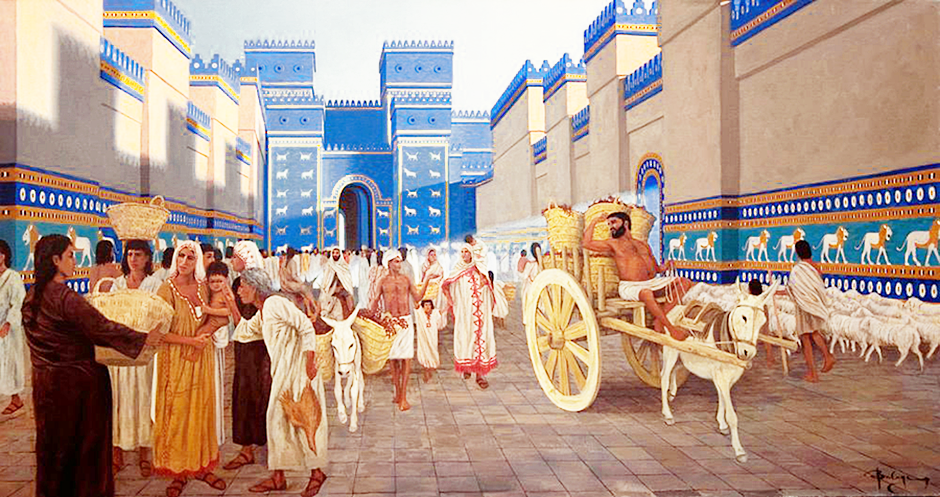
It's an imposing brick structure decorated with rows of figurations of the deities' emblematic animals. Placed like sentinels, they are supposed to intimidate and ward off evil spirits, protecting the city and its inhabitants.
Image opposite: an artistic view of the Ishtar Gate (in the background) and the Processional Way. © akg images/Balage/Balogh/archaeologyillustrated.com
This gate, erected around 575 BC, is dedicated to the eponymous goddess Ishtar, goddess of physical love and war. She appears as the very symbol of Babylon. Her «ceremonial» name is Ishtar Sakipat Tebisha, or «Ishtar is victorious over her enemies». The Gate of Ishtar is built on the principle of the double gate, i.e. sandwiched between an outer and inner wall. Although excavations have failed to find the door leaves, ancient texts such as the commemorative tablet describe them as being made of cedar wood with bronze bands.

- The second (inner) gate is the largest. It is set into the inner rampart and also has two towers. Between the two towers is an open courtyard. The constraints of the Pergamon Museum's structure prevented the reconstruction of this second gate.
Image opposite: a model of the Ishtar Gate and the Processional Way, 250 m long and 20-24 m wide. © Pergamon Museum, Berlin.
Archaeologists estimate that there have been several phases of construction, each of which has altered the setting:
- The first phase is characterized by enamelled decoration and the last phase by bas-reliefs in enamelled and coloured brick. Rows of bulls and «snake-dragons» (mushkushu) can be seen on the walls of the doors. The bull symbolizes the god Adad (god of Storm or Time). The lion, symbol of Ishtar, is not present on the walls of this entrance. Near the gateway is an inscription (partially restored) by Nebuchadnezzar detailing its construction (extract):
«...I (Nebuchadnezzar) cast the bases of the gate toward the level of the subterranean waters and built them of bluestone...on the walls of the inner chamber of the gate are bulls and dragons, which I have magnificently adorned with a lustre of luxury for all men...in fear...»
The entrances to the inner city bear witness to this quest for grandeur, which finds magnificent expression in the monumental Ishtar Gate.
Two of the 120 lions (symbols of Ishtar) depicted along the Processional Way. © Théo Truschel.
Ishtar's gate and mushkushu
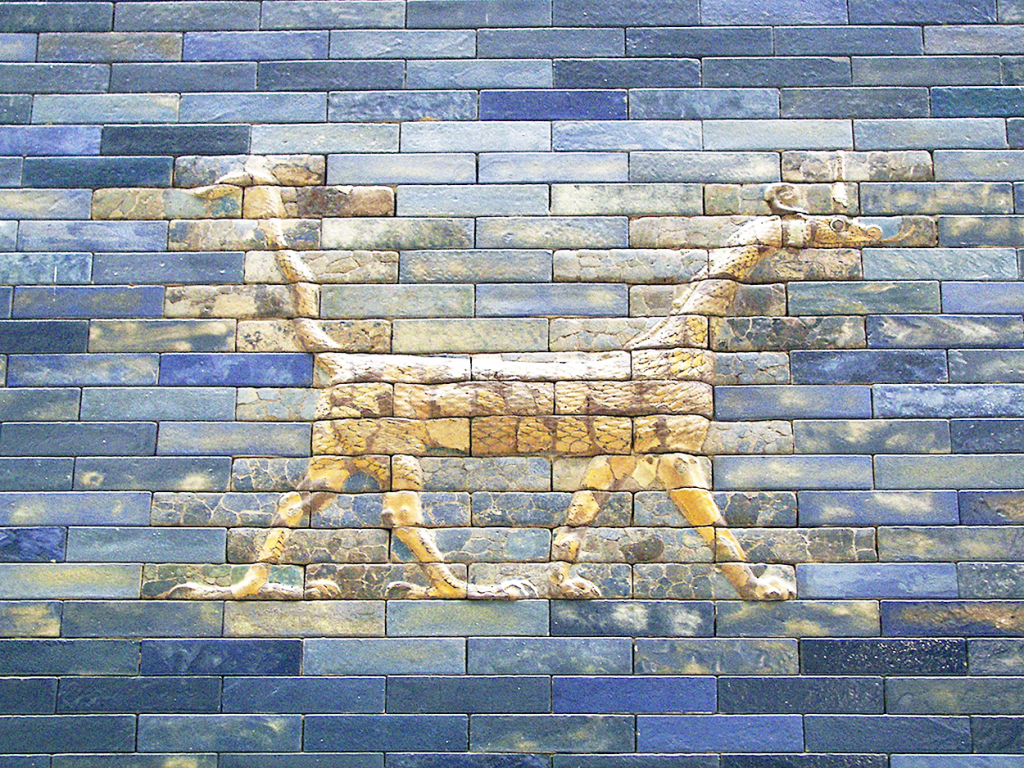
«...a slender body covered in scales, a long slender tail covered in scales and a long neck covered in scales surmounted by a snake's head. A long, forked tongue protrudes from its mouth...».
Image opposite: a mushkushu fresco on the wall of the processional way. © Théo Truschel.
This «snake-dragon» represents a hybrid creature, with the tail and body of a snake, the hind legs in the form of eagle talons or claws, and the front legs resembling those of a lion. The dragon's serpent head (mushkushu) is a representation of the god Marduk.
Some historians draw a link with the mysterious animal mentioned in the book of Bel and the Dragon (apocryphal book of the Bible). This book tells us that the Babylonian temple of Bel (another name for Marduk) is guarded by a «dragon». Nebuchadnezzar proposes to the Hebrew prophet of Yahweh, Daniel, to confront this «divinity», whom he finally kills.
Image opposite: Ishtar Gate. © Théo Truschel.
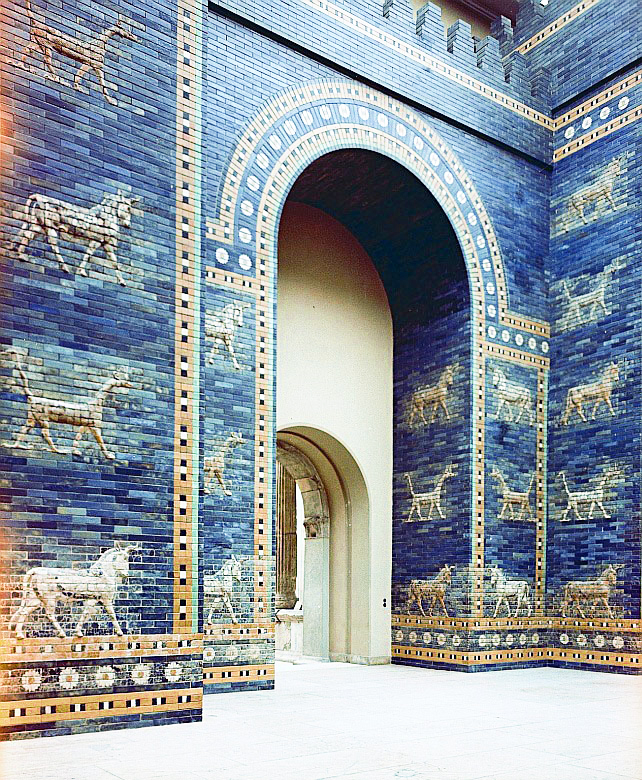
«Behold [the hippopotamus], to whom I have given life as to you! He eats grass like an ox.
Here he is! His strength is in his loins, and his vigor in the muscles of his belly; he bends his tail as firm as a cedar; The nerves of his thighs are intertwined; his bones are tubes of brass, his limbs are like bars of iron...in the frame of the lotus, he lies hidden in the reeds of the marsh...»
Cryptozoologists such as Roy P. Mackal, Willy Ley and Bernard Heuvelmans propose yet another theory: the mushkushu is an animal spotted or captured in ancient times by Neobabylonians on the banks of the Congo River in equatorial Africa. Mokélé-mbembé (literally "He who can stop the flow of the river") is the local name given today to this animal, which is surprisingly close to a sauropod dinosaur measuring around 13 metres. Its presence has been repeatedly reported by the inhabitants of the lakes and marshes near Likouala, particularly in Lake Télé (Republic of Congo). According to the natives, it feeds mainly on the fruits of a local plant, the Malombo. It is therefore herbivorous, but some witnesses claim that it also kills humans and hippos, probably to defend its territory. Its current existence has not been confirmed, despite several recent expeditions (between 1902 and 2002), various testimonies collected on site and a relatively precise drawing made by several witnesses.
Today, however, the representation of the mushkushu on the walls of Ishtar's gate is considered more symbolic. This fantastic animal appears as a synthesis of different divinities in the highly complex mythology of Mesopotamian history.

A model of the Processional Way on display at Berlin's Pergamon Museum © Pergamon Museum Berlin.
The Ishtar Gate and the Processional Way
The Processional Way follows the Ishtar Gate. It can be followed for around 800 meters. It is along this street that effigies of the gods are carried in procession during the New Year's Festival. This Way is referred to as Aj-ibur-shapû, which is translated in various ways: «the invisible enemy should not exist» (Marzahn 1994b:14), «Let not the arrogant prosper» (George 1992:67l.64), «Let not the obstinate adversary remain healthy» (GAD) S/l 492).
Image opposite: The Processional Way, partially reconstructed at Berlin's Pergamon Museum © Théo Truschel.
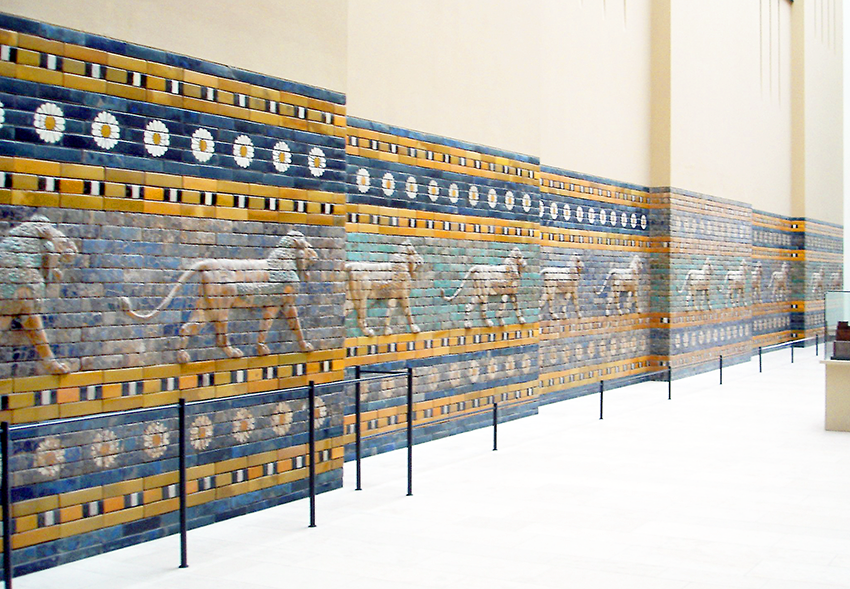
The Processional Way continues beyond the Ishtar Gate, following the eastern wall of the Southern Palace, to the Etemenanki, which it bypasses to the west and spans the Euphrates via a bridge. Alongside the Palace, the roadway descends to city level.
The parallelism of the aisles and the perfect symmetry of the architectural organization lend a solemn character that contrasts with previous Assyrian achievements.
The Ishtar Gate and the history of archaeological excavations
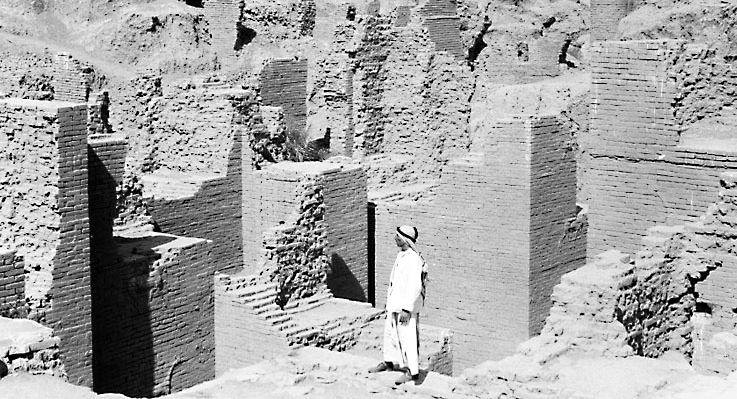
Image opposite: The first archaeological excavations at Babylon. Public domain.
Not only does he describe the hitherto mythical site, using drawings by Bellino of Tübingen in Narrative of a journey to the Site of Babylon (Récit d'un voyage sur le site de Babylone, London 1839), but he did bring back a few inscriptions, tablets and seals.
 Image opposite: the Ishtar Gate when it was first discovered. Public domain.
Image opposite: the Ishtar Gate when it was first discovered. Public domain.
He sold them to the British Museum and to Professor G. F. Grotefend, who was working on deciphering cuneiform writing. Superficial explorations were carried out by A. H. Layard in 1850 (who later devoted himself to excavating Sennacherib's palace at Nineveh) and by F. Fresnel and J. Oppert in 1852. The latter two produced the first detailed plan of the city. W. Budge carried out excavations for the British Museum in 1887, and H. Rassam carried out unscientific excavations in the 1870s and 1880s. In the 1970s, a group of German researchers also took a brief interest in the Babylonian site, and a team from the University of Turin surveyed various parts of the city in the 1970s and 1980s.
Further work, interrupted by the war, was undertaken by the Directorate of Iraqi Antiquities from 1958 onwards, but this was more of a reconstruction program. A smaller reproduction of the Ishtar Gate was erected in Iraq under Saddam Hussein to serve as the entrance to a museum that was never built. This scale model was damaged during the war.

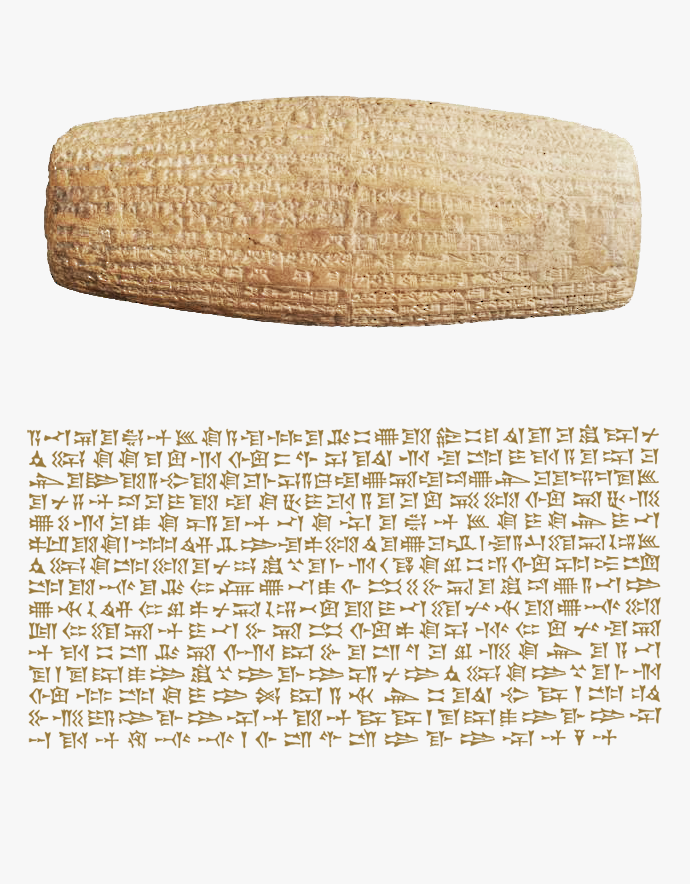
 Image opposite: a cartouche on a jar bearing the name of Neco (or Nekao II). He successfully waged war against Josiah, king of Judah, who was killed at the battle of Megiddo in 609 BC. Three months later, he captured Jehoahaz, Josiah's son and his successor as head of Judah, who died in Egypt, and imposed a tribute on the kingdom of Judah. Finally, he established Joiakim, Josiah's eldest son, as the new king of Judah. This episode is recalled in the Bible, more precisely in the Second Book of Kings, chapter 23, verses 30 to 35 © Gift of Jerome F. Snyder.
Image opposite: a cartouche on a jar bearing the name of Neco (or Nekao II). He successfully waged war against Josiah, king of Judah, who was killed at the battle of Megiddo in 609 BC. Three months later, he captured Jehoahaz, Josiah's son and his successor as head of Judah, who died in Egypt, and imposed a tribute on the kingdom of Judah. Finally, he established Joiakim, Josiah's eldest son, as the new king of Judah. This episode is recalled in the Bible, more precisely in the Second Book of Kings, chapter 23, verses 30 to 35 © Gift of Jerome F. Snyder.
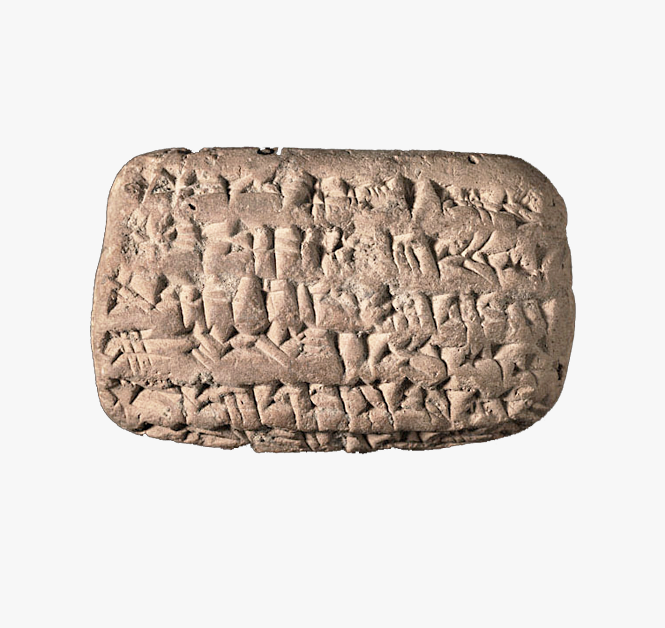


 Image opposite: the Ishtar Gate when it was first discovered. Public domain.
Image opposite: the Ishtar Gate when it was first discovered. Public domain.